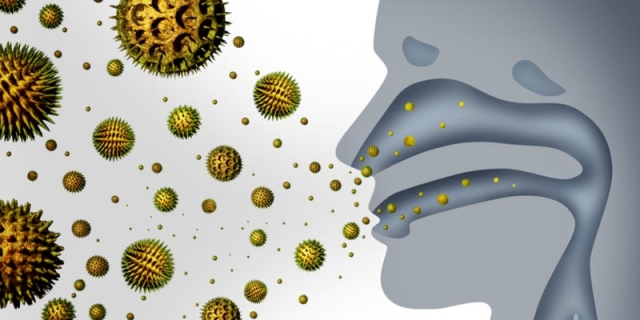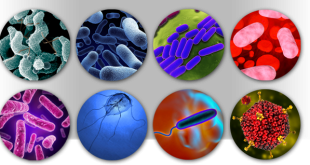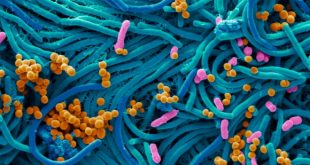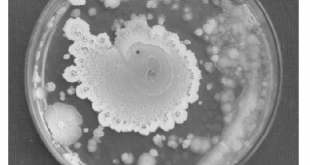Distribution of Microbes in Air
No microbes are indigenous to the atmosphere rather they represent allochthonous populations transported from aquatic and terrestrial habitats into the atmosphere. Microbes of air within 300-1,000 or more feet of the earth’s surface are the organisms of soil that have become attached to fragments of dried leaves, straw, or dust particles, being blown away by the wind. Species vary greatly in their sensitivity to a given value of relative humidity, temperature, and radiation exposures.
Air over land masses and sea
More microbes are found in the air over land masses than far at sea. Spores of fungi, especially Alternaria, Cladosporium, Penicillium, and Aspergillus are more numerous than other forms over sea within about 400 miles of land in both polar and tropical air masses at all altitudes up to about 10,000 feet. Microbes found in the air over populated land areas below the altitude of 500 feet in clear weather include spores of Bacillus and Clostridium, ascospores of yeasts, fragments of mycelium, and spores of molds and actinomycetes, pollen, protozoan cysts, algae, Micrococcus, Corynebacterium, etc.
Dust of institutions and hospitals
In the dust and air of schools and hospital wards or the rooms of persons suffering from infectious diseases, microbes such as tubercle bacilli, streptococci, pneumococci, and staphylococci have been demonstrated. These respiratory bacteria are dispersed in the air in the droplets of saliva and mucus produced by coughing, sneezing, talking, and laughing. Viruses of the respiratory tract and some enteric tract are also transmitted by dust and air. Pathogens in dust are primarily derived from objects contaminated with infectious secretions that after drying become infectious dust.
Droplets are usually formed by sneezing, coughing, and talking. Each droplet consists of saliva and mucus and each may contain thousands of microbes. It has been estimated that the number of bacteria in a single sneeze may be between 10,000 and 100,000. Small droplets in a warm, dry atmosphere are dry before they reach the floor and thus quickly become droplet nuclei.
Many plant pathogens are also transported from one field to another through the air and the spread of many fungal diseases of plants can be predicted by measuring the concentration of airborne fungal spores. Human bacterial pathogens which cause important airborne diseases such as diphtheria, meningitis, pneumonia, tuberculosis, and whooping cough.
SOURCES OF MICROORGANISMS IN THE AIR
Although a number of microorganisms are present in the air, it doesn’t have an indigenous flora. Air is not a natural environment for microorganisms as it doesn’t contain enough moisture and nutrients to support their growth and reproduction. Quite a number of sources have been found to be responsible for the air microflora.
1. Soil: One of the most common sources of air microflora is the soil. Soil microorganisms when disturbed by the wind, are liberated into the air and remain suspended there for a long period of time. Digging or plowing of the soil may also release soil microbes into the air.
2. Water: Microorganisms of water may be released into the air in the form of water droplets or aerosols. The splashing of water by wind or tidal action may also produce droplets or aerosols.
3. Plant and Animal: Air currents may bring the microorganisms from plant or animal surfaces into the air. These organisms may be either commensals or plant or animal pathogens. For example, spores of Puccinia graminis travel over a thousand kilometers.
The main source of airborne microorganisms is human beings. Their surface flora may be shed at times and may be disseminated into the air. Similarly, the commensal, as well as pathogenic flora of the upper respiratory tract and the mouth, are constantly discharged into the air by activities like coughing, sneezing, talking, and laughing.
The microorganisms are discharged out in three different forms which are grouped on the basis of the irrelative size and moisture content. They are droplets, droplet nuclei, and infectious dust.
Droplet
Droplets are usually formed by sneezing, coughing, or talking. Each consists of saliva and mucus. Droplets may also contain hundreds of microorganisms which may be pathogenic if discharged from diseased persons. Pathogens will be mostly of respiratory tract origin. Most droplets are relatively large and about 100m in size. The size of the droplet determines the time period during which it can remain suspended. When inhaled these droplets are trapped on the moist surfaces of the respiratory tract. Thus, the droplets containing pathogenic microorganisms may be a source of infectious disease.
Droplets are usually formed by sneezing, coughing, and talking. Each droplet consists of saliva and mucus and each may contain thousands of microbes. It has been estimated that the number of bacteria in a single sneeze may be between 10,000 and 100,000.
Droplet Nuclei
Small droplets in a warm, dry atmosphere tend to evaporate rapidly and become droplet nuclei. Thus, the residue of solid material left after drying up of a droplet is known as droplet nuclei. These are small, 1-4µm, and light. They can remain suspended in the air for hours or days, traveling long distances. The droplet nuclei may act as more potential agents of infectious diseases than droplets. Small droplets in a warm, dry atmosphere are dry before they reach the floor and thus quickly become droplet nuclei.
Infectious Dust
Large aerosol droplets settle out rapidly from the air onto various surfaces and get dried. Nasal and throat discharges from a patient can also contaminate surfaces and become dry. Disturbance of this dried material by bed making, handling a handkerchief having dried secretions or sweeping floors in the patient’s room can generate dust particles that add microorganisms to the circulating air. Most dust particles are laden with microorganisms.
Survival time of Microorganisms in the Atmosphere
1. Bacillus sp., Clostridium sp.: Can survive 200 years in the air-dried state.
2. Salmonella typhi: Can survive 6-10 minutes
3. Vibrio cholerae: Can survive only 2-6 minutes in the air.
Effects of pigment on microbial susceptibility
1. Micrococcus luteus: Non pigmented strain-Susceptible to UV
2. Micrococcus luteus: Yellow pigmented strain-Resistant to UV
Importance of Air microflora
Knowledge of microorganisms in the air is important in several aspects.
- In human health: The significance of Air Microflora in human health relies on the fact that air acts as a medium for the transmission of infectious agents. An adult man inhales about 15 m3 of air per day. Staphylococcus aureus is the most commonly found pathogen in the air since the carriers are commonly present. The number of S.aureus in the air may vary between o to 1/m3 and 150/m3.
- In hospitals: Although hospitals are war fields for combating diseases, there are certain occasions in which additional new infectious diseases can be acquired during hospitalization. The air within the hospitals may act as a reservoir of pathogenic microorganisms, which are transmitted by the patients. Infections acquired during hospitalization are called Nosocomial infections and the pathogens involved are called Nosocomial pathogens.
- Spoilage of food and fermentation products: Microorganisms are often troublesome in the home and in an industry where foods and other fermentation products are prepared. In industrial processes, where particular organisms are to be grown, supplying sterile air free from contaminating organisms is a considerable problem.
Revised by
- Md. Siddiq Hasan on 5 march,2021
 Plantlet The Blogging Platform of Department of Botany, University of Dhaka
Plantlet The Blogging Platform of Department of Botany, University of Dhaka





